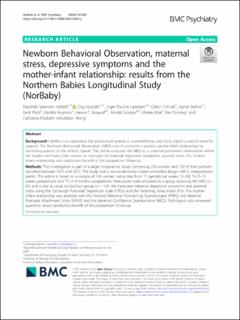| dc.contributor.author | Høifødt, Ragnhild Sørensen | |
| dc.contributor.author | Nordahl, Dag | |
| dc.contributor.author | Landsem, Inger Pauline | |
| dc.contributor.author | Csifcsak, Gabor | |
| dc.contributor.author | Bohne, Agnes | |
| dc.contributor.author | Pfuhl, Gerit | |
| dc.contributor.author | Rognmo, Kamilla | |
| dc.contributor.author | Braarud, Hanne Cecilie | |
| dc.contributor.author | Goksøyr, Arnold Mikal | |
| dc.contributor.author | Moe, Vibeke | |
| dc.contributor.author | Slinning, Kari | |
| dc.contributor.author | Wang, Catharina Elisabeth Arfwedson | |
| dc.coverage.spatial | Norway, Tromsø | en_US |
| dc.date.accessioned | 2020-08-10T11:47:56Z | |
| dc.date.available | 2020-08-10T11:47:56Z | |
| dc.date.created | 2020-06-17T19:10:46Z | |
| dc.date.issued | 2020 | |
| dc.identifier.citation | Høifødt, R. S., Nordahl, D., Landsem, I. P., Csifcsák, G., Bohne, A., Pfuhl, G., … Wang, C. E. A. (2020). Newborn Behavioral Observation, maternal stress, depressive symptoms and the mother-infant relationship: results from the Northern Babies Longitudinal Study (NorBaby). BMC Psychiatry, 20(1). | en_US |
| dc.identifier.issn | 1471-244X | |
| dc.identifier.uri | https://hdl.handle.net/11250/2671362 | |
| dc.description.abstract | Background
Families can experience the postpartum period as overwhelming and many report a special need for support. The Newborn Behavioral Observation (NBO) aims to promote a positive parent-infant relationship by sensitising parents to the infant’s signals. This article evaluates the NBO as a universal preventive intervention within the regular well-baby clinic service on measures of maternal depressive symptoms, parental stress, the mother-infant relationship and satisfaction/benefit of the postpartum follow-up.
Methods
This investigation is part of a larger longitudinal study comprising 220 women and 130 of their partners recruited between 2015 and 2017. The study had a non-randomised cluster-controlled design with 6 measurement points. This article is based on a sample of 196 women using data from T1 (gestational weeks 13–39), T4 (5–15 weeks postpartum) and T5 (3–9 months postpartum). Participants were allocated to a group receiving the NBO (n = 82) and a care as usual comparison group (n = 114). We measured maternal depressive symptoms and parental stress using the Edinburgh Postnatal Depression Scale (EPDS) and the Parenting Stress Index (PSI). The mother-infant relationship was assessed with the Parental Reflective Functioning Questionnaire (PRFQ), the Maternal Postnatal Attachment Scale (MPAS) and the Maternal Confidence Questionnaire (MCQ). Participants also answered questions about satisfaction/benefit of the postpartum follow-up.
Results
A Mann-Whitney U test indicated that participants in the NBO-group learned significantly more than the comparison group from the follow-up about the baby’s signals in relation to sleep/sleep patterns, social interaction and crying/fuzziness. Multivariate analyses of covariance (MANCOVA) and repeated measures ANCOVA found no significant differences between the groups for the mother-infant relationship domain and few differences in depressive symptoms and parental stress. The repeated measures ANCOVA found that participants in the NBO-group scored slightly higher on parental stress, although the difference was small.
Conclusions
The results indicate that the NBO-group learned more than the comparison group about reading their child’s signals in important everyday situations. However, the benefits of the NBO were limited for depressive symptoms, parental stress and self-reported mother-infant relationship. The study sample was generally well-functioning, and the results indicate that the benefits of the NBO may be limited within a well-functioning sample. | en_US |
| dc.language.iso | eng | en_US |
| dc.publisher | BioMed Central | en_US |
| dc.rights | Navngivelse 4.0 Internasjonal | * |
| dc.rights.uri | http://creativecommons.org/licenses/by/4.0/deed.no | * |
| dc.subject | newborn behavioral observation | en_US |
| dc.subject | intervention | en_US |
| dc.subject | parenting stress | en_US |
| dc.subject | postpartum depression | en_US |
| dc.subject | mother-infant relationship | en_US |
| dc.title | Newborn Behavioral Observation, maternal stress, depressive symptoms and the mother-infant relationship: results from the Northern Babies Longitudinal Study (NorBaby) | en_US |
| dc.type | Peer reviewed | en_US |
| dc.type | Journal article | en_US |
| dc.description.version | publishedVersion | en_US |
| dc.rights.holder | © The Author(s) 2020 | en_US |
| dc.source.pagenumber | 14 | en_US |
| dc.source.volume | 20 | en_US |
| dc.source.journal | BMC Psychiatry | en_US |
| dc.source.issue | 300 | en_US |
| dc.identifier.doi | 10.1186/s12888-020-02669-y | |
| dc.identifier.cristin | 1816024 | |
| cristin.ispublished | true | |
| cristin.fulltext | original | |
| cristin.qualitycode | 1 | |

